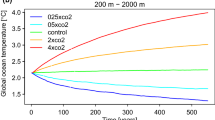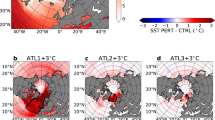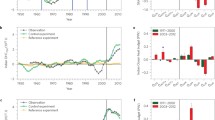Abstract
The heat budget of the upper Arctic Ocean is examined in an ensemble of coupled climate models under idealised increasing CO2 scenarios. All of the experiments show a strong amplification of surface air temperatures but a smaller increase in sea surface temperature than the rest of the world as heat is lost to the atmosphere as the sea-ice cover is reduced. We carry out a heat budget analysis of the Arctic Ocean in an ensemble of model runs to understand the changes that occur as the Arctic becomes ice free in summer. We find that as sea-ice retreats heat is lost from the ocean surface to the atmosphere contributing to the amplification of Arctic surface temperatures. Furthermore, heat is mixed upwards into the mixed layer as a result of increased upper ocean mixing and there is increased advection of heat into the Arctic as the ice edge retreats. Heat lost from the upper Arctic Ocean to the atmosphere is therefore replenished by mixing of warmer water from below and by increased advection of warm water from lower latitudes. The ocean is therefore able to contribute more to Arctic amplification.







Similar content being viewed by others
References
Bitz C, Gent P, Woodgate R, Holland M, Lindsay R (2006) The influence of sea ice on ocean heat uptake in response to increasing CO2. J Clim 19:2437–2450
Boé J, Hall A, Qu X (2009) Current GCMs’ unrealistic negative feedback in the Arctic. J Clim 22:4682–4695. doi:10.1175/2009JCLI2885.1
Christensen J, Hewitson B, Busuioc A, Chen A, Gao X, Held I, Jones R, Kolli R, Kwon W, Laprise R, Magana Rueda V, Mearns L, Menendez C, Raisanen J, Rinke A, Sarr A, Whetton P (2007) Chapter 11: Regional climate projections. In: Climate change 2007: The physical science basis. Contribution of working group I to the fourth assessment report of the intergovernmental panel on climate change, Cambridge University Press, Cambridge
Gordon C, Cooper C, Senior C, Banks H, Gregory J, Johns T, Mitchell J, Wood R (2000) The simulation of SST, sea ice extents and ocean heat transports in a version of the Hadley Centre coupled model without flux adjustments. Clim Dyn 16:147–168
Hunke E, Dukowicz J (1997) An elastic-viscous-plastic model for sea ice dynamics. J Phys Oceanogr 27(9):1849–1867
Hunke E, Lipscomb W (2004) Cice: the los alamos sea ice model, documentation and software, version 3.1. Los Alamos National Laboratory, LA-CC-98-16
Jackson J, Carmack E, McLaughlin F, Allen S, Ingram R (2010) Identification, characterization, and change of the near-surface temperature maximum in the canada basin, 1993–2008. J Geophys Res 115. doi:10.1029/2009JC005265
Johannessen O, Bengtsson L, Miles M, Kuzmina S, Semenov V, Alekseev G, Nagurnyi A, Zakhorov V, Bobylev L, Pettersson L, Hasselmann K, Cattle H (2004) Arctic climate change: observed and modelled temperature and sea-ice variability. Tellus A 56(4):328–341. doi:10.1111/j.1600-0870.2004.00060.x
Johns T, Durman C, Banks H, Roberts M, McLaren A, Ridley J, Senior C, Williams K, Jones A, Rickard G, Cusack S, Ingram W, Crucifix M, Sexton D, Joshi M, Dong BW, Spencer H, Hill R, Gregory J, Keen A, Pardaens A, Lowe J, Bodas-Salcedo A, Stark S, Searl Y (2006) The new Hadley Centre climate model HadGEM1: evaluation of coupled simulations. J Clim 19(7):1327–1353
Kraus E, Turner J (1967) A one dimensional model of the seasonal thermocline. Part II. Tellus A 19:98–105
Lipscomb W (2001) Remapping the thickness distribution in sea ice models. J Geophys Res 106(C7):13
Manabe S, Stouffer R (1980) Sensitivity of a global climate model to an increase of CO2 concentration in the atmosphere. J Geophys Res 85:5529–5554
Manabe S, Wetherald R (1975) The effects of doubling the CO2 concentration on the climate of a general circulation model. J Atmos Sci 32:3–15
McLaren A, Banks H, Durman C, Gregory J, Johns T, Keen A, Ridley J, Roberts M, Lipscomb W, Connolley W, Laxon S (2006) Evaluation of the sea ice simulation in a new coupled atmosphere-ocean climate model (HadGEM1). J Geophys Res 111:C12014. doi:10.1029/2005JC003033
McPhee M, Proshutinsky A, Morison J, Steele M, Alkire M (2009) Rapid change in freshwater content of the Arctic Ocean. Geophys Res Lett 36:L10602. doi:10.1029/2009GL037525
Paulson C, Simpson J (1977) Irradiance measurements in the upper ocean. J Phys Oceanogr 7:952–956
Polyakov I, Timokhov L, Alexeev V, Bacon S, Dmitrenko I, Fortier L, Frolov I, Gascard J, Hansen E, Ivanov V et al (2010) Arctic ocean warming contributes to reduced polar ice cap. J Phys Oceanogr 40(12):2743–2756
Rigor IG, Colony RL, Martin S (2000) Variations in surface air temperature observations in the Arctic, 1979-97. J Clim 13(5):896–914
Screen J, Simmonds I (2010) The central role of diminishing sea-ice in recent Arctic temperature amplification. Nature 464:1334–1337. doi:10.1038/nature09051
Screen J, Simmonds I (2010b) Increasing fall-winter energy loss from the Arctic ocean and its role in Arctic temperature amplification. Geophys Res Lett 37:L16707. doi:10.1029/2010GL044136
Serreze M, Francis J (2006) The Arctic amplification debate. Clim Change 76:241–264. doi:10.1007/s10584-005-9017-y
Steele M, Morley R, Ermold W (2001) Phc: a global ocean hydrography with a high-quality arctic ocean. J Clim 14(9):2079–2087
Steele M, Ermold W, Zhang J (2011) Modelling the formation and fate of the near-surface temperature maximum in the Canadian basin of the Arctic Ocean. J Geophys Res 116:C11015. doi:10.1029/2010JC006803
Tietsche S, Notz D, Jungclaus J, Marotzke J (2011) Recovery mechanisms of arctic summer sea ice. Geophys Res Lett 38:L02707
Toole J, Tinnermans M, Perovich D, Krishfield R, Proshutinsky A, Richter-Menge J (2010) Influences of the ocean surface mixed layer and thermohaline stratification on arctic sea ice in the central Canada basin. J Geophys Res 115:C10018. doi:10.1029/2009JC005660
Vellinga M, Wu P (2008) Relations between northward ocean and atmosphere energy transports in a coupled climate model. J Clim 21:561–575
Acknowledgments
This work was supported by the Joint DECC/Defra Met Office Hadley Centre Climate Programme (GA01101). We would also like to acknowledge Jeff Ridley, Peili Wu and and Angus Ferraro for their valued comments during this research and Glen Harris for his guidance in setting up the PPE. Finally thank you to the two anonymous reviewers for their helpful comments and suggestions
Author information
Authors and Affiliations
Corresponding author
Rights and permissions
About this article
Cite this article
Graham, T., Vellinga, M. Heat budget of the upper Arctic Ocean under a warming climate. Clim Dyn 40, 143–153 (2013). https://doi.org/10.1007/s00382-012-1454-5
Received:
Accepted:
Published:
Issue Date:
DOI: https://doi.org/10.1007/s00382-012-1454-5




